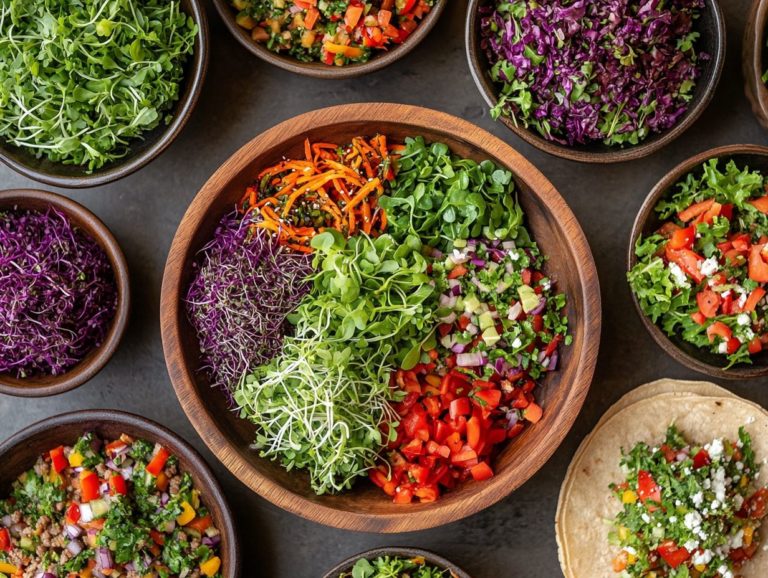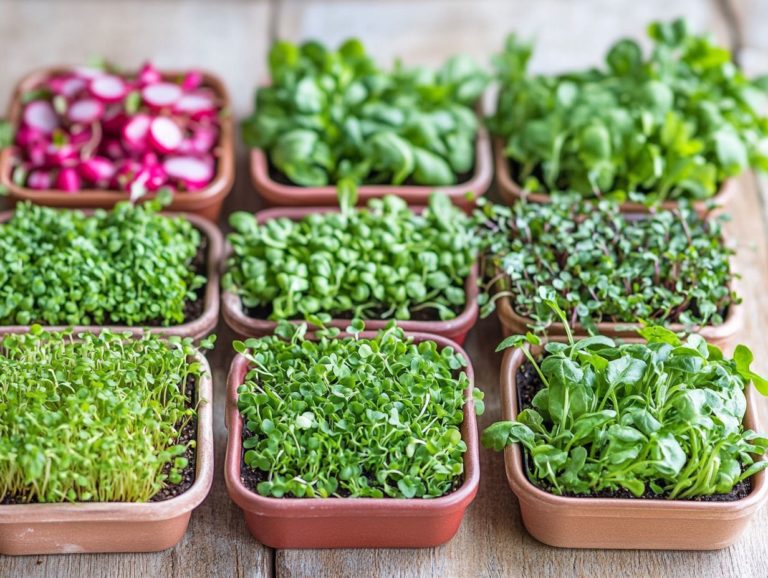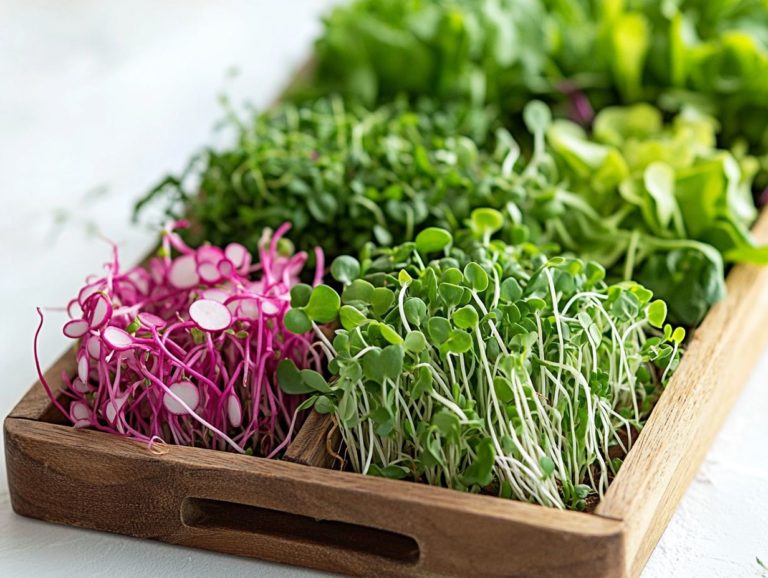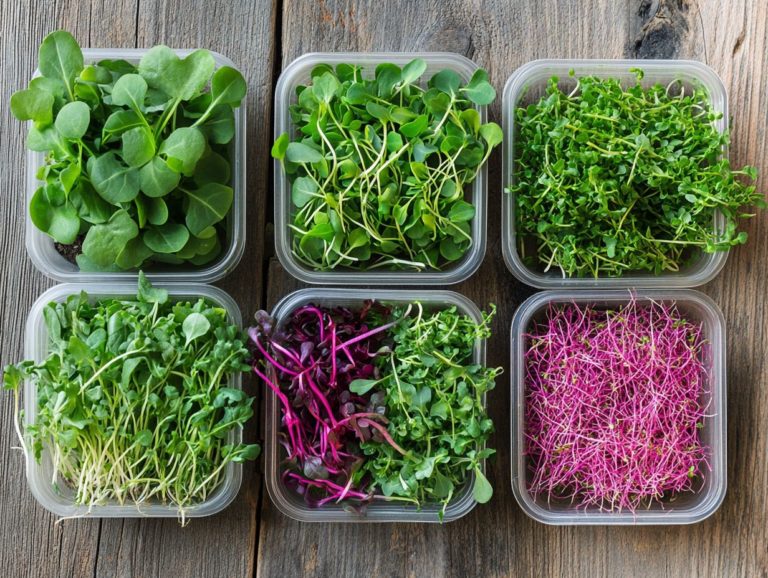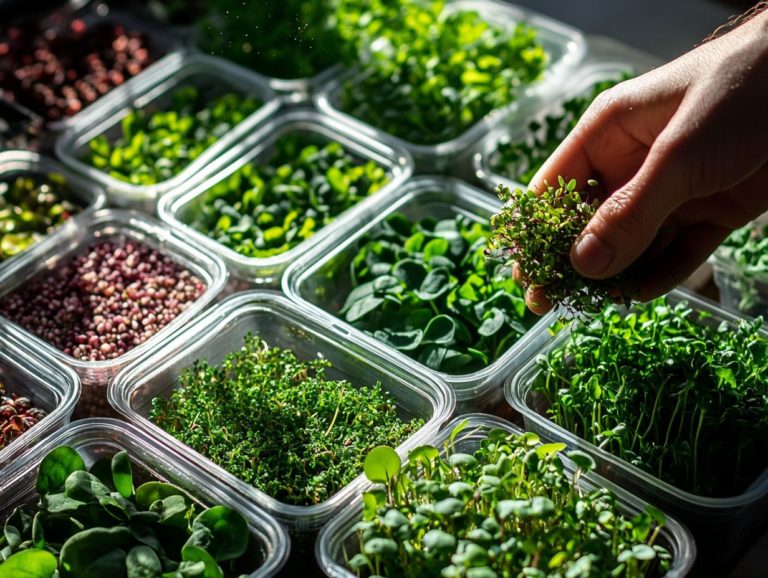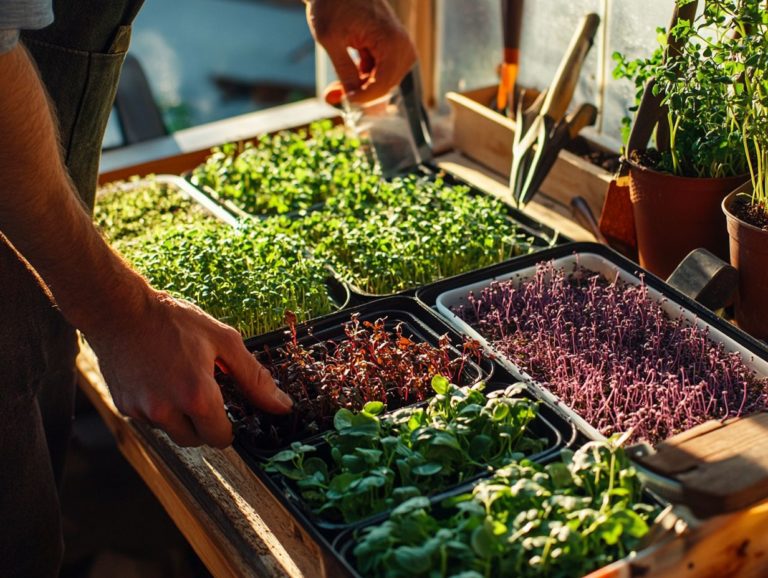Exploring the Culinary World of Microgreen Varieties
Microgreens are tiny, edible plants. They add a burst of flavor and nutrition, making them a favorite for chefs and home cooks.
From the peppery zing of arugula to the sweet notes of basil, these vibrant greens come in a variety of types. Varieties like basil microgreens and cilantro microgreens each bring their own unique taste profile to the table.
This guide will walk you through common microgreen varieties, the process of growing them, and inventive ways to incorporate them into your cooking, including innovative cooking techniques.
You ll also discover their impressive health benefits. Additionally, you ll receive tips for selecting and storing the freshest microgreens, ensuring their antioxidant properties and nutrient-rich qualities are preserved.
Elevate your culinary creations with these delightful greens, packed with intense flavors and health benefits!
Contents
- Key Takeaways:
- Types of Microgreens
- Growing and Harvesting Microgreens
- Uses for Microgreens in Cooking
- Nutritional Benefits of Microgreens
- Tips for Buying and Storing Microgreens
- Frequently Asked Questions
- 1. What are microgreens and why are they popular in the culinary world?
- 2. How are microgreens different from sprouts?
- 3. What are the most commonly used microgreen varieties in cooking?
- 4. Can microgreens be grown at home?
- 5. How can microgreens be used in cooking?
- 6. Are there any health benefits of consuming microgreens?
Key Takeaways:
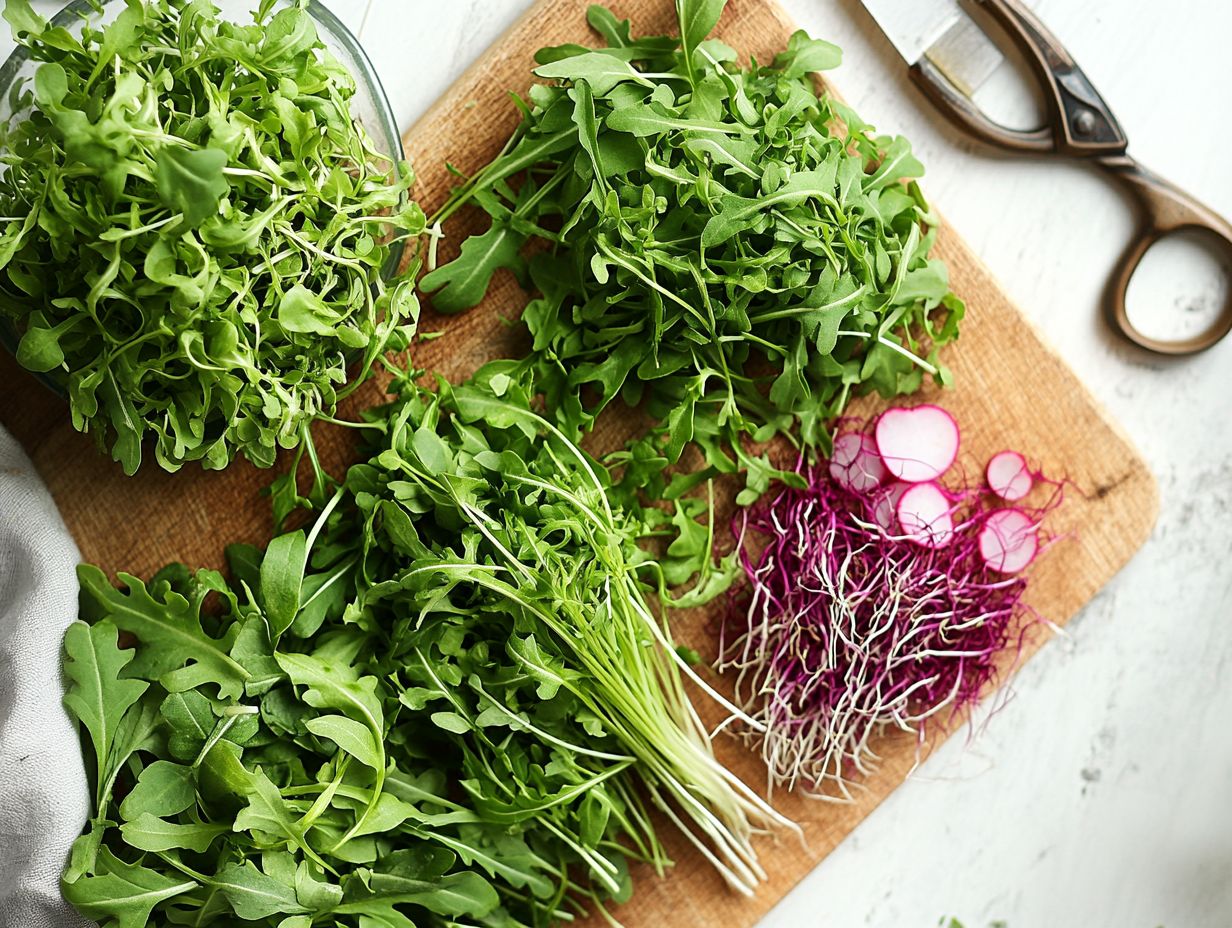
- Microgreens are young vegetable greens packed with flavor and nutrients. They are a versatile and tasty addition to any dish, perfect for urban agriculture enthusiasts.
- From peppery arugula to tangy sorrel, there is a wide variety of microgreens available, including radish microgreens. Each has its own unique flavor profile to enhance your culinary creations.
- Microgreens are easy to grow and harvest at home. They also offer a higher concentration of nutrients, including vitamins and antioxidants, compared to their mature counterparts, making them a nutritious choice for any meal.
What are Microgreens?
Microgreens are young, edible plants that you harvest just after the first true leaves appear. They bring a burst of unique flavors and vibrant colors to elevate any dish. These nutrient-rich plants, including varieties like basil microgreens, cilantro microgreens, and mustard greens, not only add visual flair but also offer impressive health benefits such as immune support and antioxidant properties, essential for wellness.
As you delve into growing food in city settings, you’ll find that cultivating microgreens is an accessible and rewarding pursuit.
The culinary possibilities with these tiny greens are expansive. They enhance everything from salads to sandwiches and even gourmet dishes in upscale restaurants, showcasing their unique flavors. Chefs love the intense flavors and diverse textures that microgreens provide, enabling them to craft visually stunning presentations.
Each variety boasts its own distinct flavor profile. For instance, radish microgreens deliver a peppery kick, while pea shoots offer a hint of sweetness, making them essential in cooking techniques.
By cultivating microgreens in urban settings, you’re not just promoting local food systems you re also contributing to better nutrition and the growth of urban agriculture. This movement reflects a rising awareness of health-conscious eating and sustainable living.
Types of Microgreens
The realm of microgreens presents a captivating variety. Each offers its own distinctive flavors, vibrant hues, and culinary possibilities, elevating every meal to new heights. Consider popular varieties such as pea shoots, radish microgreens, and sunflower shoots; they not only beautify your dishes but also introduce unique taste profiles, enhancing culinary applications.
This enables both chefs and home cooks to creatively explore and experiment with these nutrient-dense ingredients, enriching their culinary repertoire.
Common Varieties and Their Flavor Profiles
Common varieties of microgreens, such as pea shoots, radish, sunflower, basil, cilantro, and mustard greens, each bring distinct and intense flavors that can elevate your culinary creations. These micro herbs introduce unique tastes and infuse your dishes with freshness and bright colors. They are essential for both gourmet chefs and gardening enthusiasts alike.
Take pea shoots, for example. They offer a sweet, garden-fresh note that pairs beautifully with salads and light pastas.
Radish microgreens, on the other hand, deliver a peppery kick that’s perfect for enhancing sandwiches and tacos.
Sunflower microgreens, celebrated for their nutty flavor, can elevate your grain bowls and smoothies, adding both texture and nutrition.
Basil microgreens, with their aromatic sweetness, complement Italian dishes and dressings seamlessly. The zesty sharpness of cilantro microgreens can truly enliven salsas and Asian cuisines.
Mustard greens bring robust, spicy notes, making them an excellent addition to stir-fries and savory pancakes.
With these unique flavors, you can effortlessly transform everyday meals into extraordinary culinary experiences.
Growing and Harvesting Microgreens
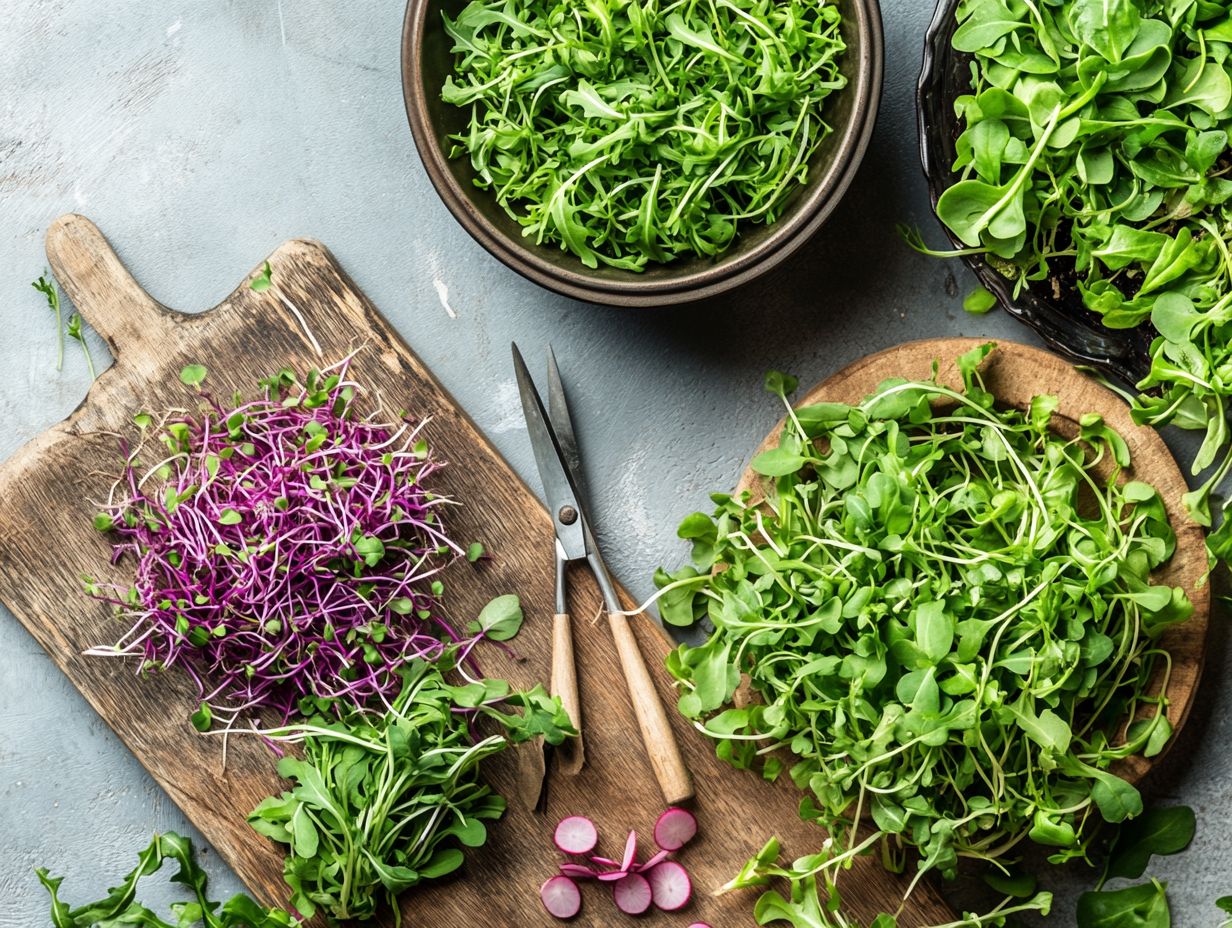
Growing microgreens is a fun hobby that you can easily pursue, whether indoors or outdoors. This delightful activity offers a great experience for both beginners and experienced gardeners.
With just a small amount of space and resources, you can grow a variety of microgreens, enjoying their bright colors and distinctive flavors. Beyond their visual appeal, these tiny greens are packed with health benefits, supporting your immune system while offering important nutrients.
Step-by-Step Guide
To successfully grow microgreens, follow this step-by-step guide that covers everything from selecting seeds to harvesting your nutrient-rich crop. This approach ensures that even if you’re a beginner, you can fully enjoy the process and rewards of cultivating your own fresh herbs.
Start with seed selection. Choose varieties like basil and cilantro, which are bursting with flavor and rich in nutrients. Once you’ve picked your seeds, prepare the soil to ensure it s rich in organic matter and drains well this sets the stage for sprouting.
Water gently, keeping the soil moist but not soggy. As your microgreens grow, those vibrant greens will be ready for a careful harvest. Use scissors to cut them at the base, ensuring they stay fresh and strong throughout your gardening journey. Get ready for an enjoyable and fulfilling gardening adventure!
Uses for Microgreens in Cooking
Microgreens offer a wealth of culinary possibilities, enhancing dishes with their bold flavors and striking colors. They are vital ingredients in modern cooking.
Whether you’re garnishing gourmet plates or adding depth to salads and sandwiches, these nutrient-packed micro herbs like radish microgreens and sunflower shoots can transform ordinary meals into extraordinary experiences through their intense flavors.
Try growing your own microgreens at home and explore different options with microgreen varieties: a guide for beginners to experiment with them in your cooking!
Creative Ways to Incorporate Microgreens into Dishes
There are countless creative ways to incorporate microgreens into your dishes, allowing you to harness their unique flavors and vibrant colors in innovative cooking methods. Whether you use them as a garnish, blend them into sauces, or toss them into salads, these fresh herbs will elevate both the presentation and taste of your meals making them essential in contemporary cooking.
For example, a sprinkle of radish microgreens can transform simple avocado toast, adding a peppery kick that contrasts beautifully with the creaminess of the avocado. Fold basil microgreens into your homemade pesto for a fresh twist on a classic recipe, invigorating your pasta dishes with an aromatic punch.
When paired with proteins like grilled chicken or fish, these tiny greens enhance visual appeal and add a subtle crunch and depth of flavor. By experimenting with combinations, such as pea shoots in a stir-fry or arugula microgreens in a gourmet sandwich, you’ll discover the versatility of microgreens as culinary herbs. To learn more about selecting the best options for your garden, check out this guide on how to choose microgreen varieties. Don’t miss out on the chance to boost your meals!
Nutritional Benefits of Microgreens
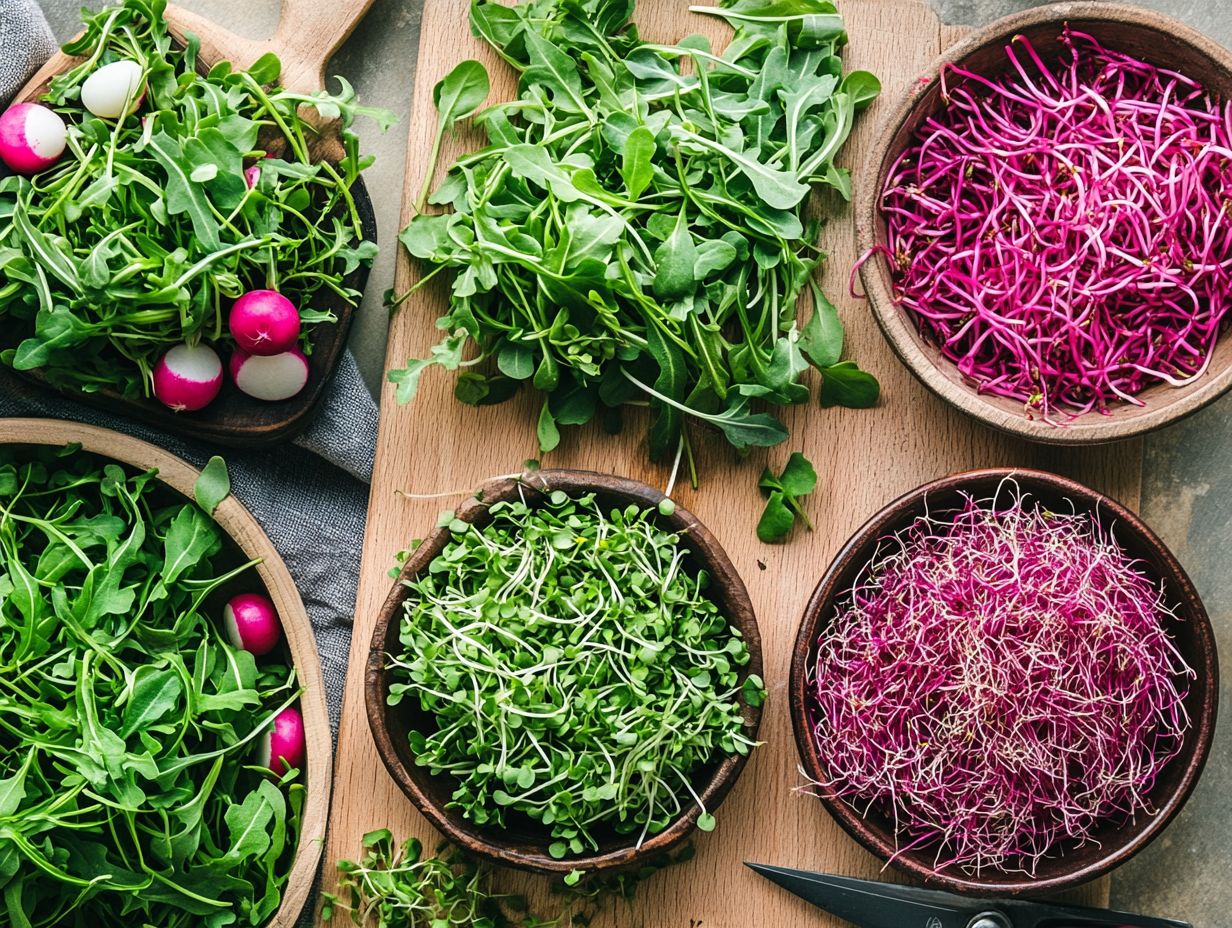
Microgreens are renowned for their exceptional nutritional benefits, often boasting higher concentrations of vitamins, minerals, and antioxidants than their fully grown counterparts. Incorporating these nutrient-dense plants into your diet provides health advantages that range from bolstering your immune system to enhancing overall wellness.
Embracing microgreens is a significant step toward better health. To enhance your culinary experience, check out the microgreen varieties: taste and flavor guide and start incorporating these tiny powerhouses into your meals today for immediate health benefits!
Comparing Nutrient Content to Mature Greens
When you compare microgreens to mature counterparts, the former often outshine them in nutrient density. They pack a punch with higher levels of vitamins, antioxidants, and essential compounds that significantly benefit your health. This superior nutrient profile makes microgreens a valuable addition to your diet, especially if you re aiming to enhance your daily intake of essential nutrients.
Research highlights that broccoli microgreens contain significantly higher concentrations of sulforaphane a compound believed to help prevent cancer and numerous medicinal properties compared to fully grown broccoli (Zhang et al., 2014). Similarly, red cabbage microgreens deliver an impressive boost, offering 6 to 40 times more vitamins C and E than their mature versions. This emphasizes their unique role in promoting overall health and their significance in urban agriculture (Xiao et al., 2012).
Incorporating microgreens into your meals not only elevates the flavor but also enriches your diet with vital nutrients, including antioxidants and vitamins. This can make a noticeable difference in your well-being.
Tips for Buying and Storing Microgreens
When considering the purchase and storage of microgreens, choosing top-notch products and mastering proper storage techniques greatly enhances their freshness and longevity.
These vibrant herbs deserve to be handled with utmost care to maintain their distinctive flavors and nutritional benefits, ensuring they continue to be a delightful and healthful enhancement to your culinary creations.
How to Choose and Keep Fresh Microgreens
Choosing and maintaining fresh microgreens requires a keen eye for detail. Strive to ensure they retain their flavor and nutritional value for your culinary endeavors. Look for vibrant colors and crisp textures. Proper storage techniques will help prolong their shelf life while preserving their unique flavors.
When selecting microgreens, evaluate signs of freshness; those vivid hues typically indicate freshness and optimal nutrient content. Examine the packaging for crucial information, such as harvesting dates and organic certifications, to secure a top-notch product.
If you want to enjoy the full benefits of these delicate greens, proper storage is essential. Keep your microgreens in a container that allows air to circulate in the refrigerator to prevent moisture buildup, which can lead to wilting.
Aim to use them within a week of purchase to relish their delightful crunch and robust taste, elevating your culinary creations to new heights.
Frequently Asked Questions
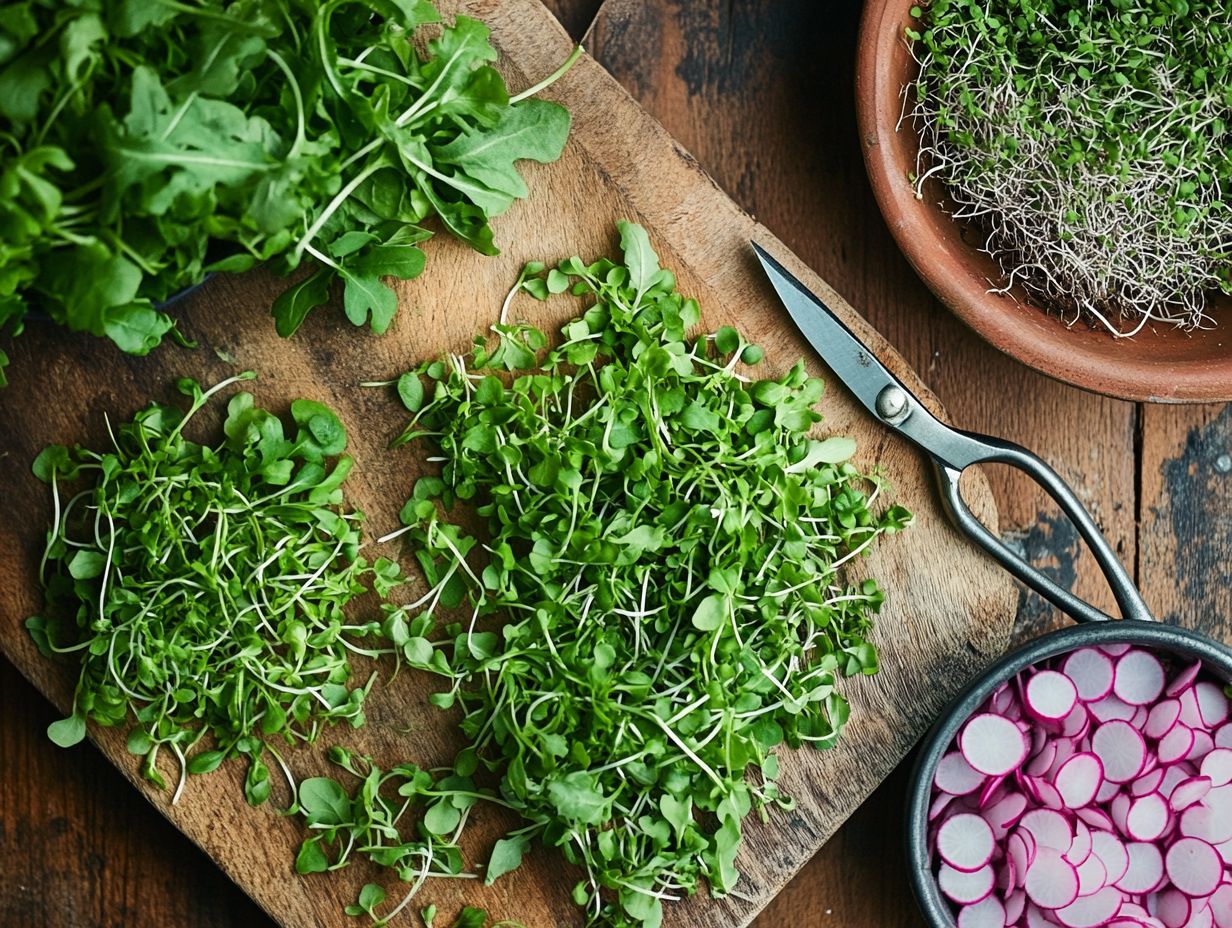
1. What are microgreens and why are they popular in the culinary world?
Microgreens are young edible plants harvested just after their first true leaves develop. They are popular in the culinary world for their unique flavors, textures, and nutrient density.
2. How are microgreens different from sprouts?
Microgreens differ from sprouts as they are grown in soil and harvested after the first true leaves develop. Sprouts are germinated seeds typically eaten with the roots still attached.
3. What are the most commonly used microgreen varieties in cooking?
Commonly used microgreen varieties in cooking include arugula, basil, cilantro, kale, and pea shoots. Many other varieties offer unique flavors and uses.
4. Can microgreens be grown at home?
Yes, microgreens can be easily grown at home with a sunny windowsill or a grow light. They require minimal space and can be harvested within a week or two after planting.
5. How can microgreens be used in cooking?
Microgreens can be used in various ways in cooking. They make great garnishes for soups, salads, and sandwiches, or can be incorporated into dishes for added flavor, texture, and nutrients.
6. Are there any health benefits of consuming microgreens?
Yes, microgreens are packed with nutrients and antioxidants, making them a great addition to a healthy diet. They are also a good source of fiber, aiding digestion and weight management.
Start growing your own microgreens today and enjoy their fresh flavors!

